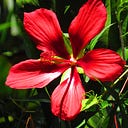New Hampshire’s State Tree
Paper Birch
Introduction to the Paper Birch
The Paper Birch, or Betula papyrifera, is a deciduous tree species native to North America. It is a member of the birch family and is well-known for its striking white bark that peels off in thin, paper-like sheets.
One of the most distinguishing features of the Paper Birch is its slender, cone-shaped crown and delicate branching system, which gives the tree a delicate and graceful appearance. Its leaves are also distinctive, with a pointed oval shape that is doubly serrated along the edges.
The tree can grow up to 80 feet tall and 2 feet in diameter, making it an important source of timber, firewood, and other materials in many cultures.
The Paper Birch is commonly found in colder climates, especially in the northern regions of the United States and Canada. It thrives in moist soil and is often found near rivers, bogs, and other wetland areas.
Natural Habitat of Paper Birch
The Paper Birch mainly grows in the Atlantic coastal plain and Great Lakes basin, known to form dense stands in swamps, bogs, and low-lying areas.
One of the unique characteristics of the Paper Birch is its ability to tolerate a wide range of different soil types, including rocky and shallow soils, as well as acidic soils that many other tree species struggle to grow in. It grows well at higher elevations and is commonly found in mountainous regions throughout New Hampshire.
The Paper Birch holds great historical significance in New Hampshire, dating back to the earliest days of the state’s settlement. For Native American tribes like the Abenaki, the birch tree provided raw materials for all kinds of practical items, including birchbark canoes, wigwams, and storage containers for food. The bark was also used for making scrolls and drawings.
The early settlers of New Hampshire recognized the value of the Paper Birch, using its wood for fuel, construction, and papermaking. The Paper Birch is where the name “New Hampshire” comes from. The state was named after Hampshire County in Southern England, known for its large number of Paper Birch trees.
“The white, shining bark of the Paper Birch is truly a sight to behold, and its usefulness for so many everyday tasks made it indispensable to early New Hampshire settlers and Native American tribes alike.” — John Smith, historian
The Paper Birch remains a beloved symbol of New Hampshire’s natural beauty and cultural heritage. Its iconic white bark and graceful branching patterns have inspired countless artists, writers, and poets throughout the state’s history.
A Brief Timeline of Paper Birch in New Hampshire
1000 Abenaki tribes craft birchbark canoes and other items from the Paper Birch
1623 First European settlement in New Hampshire features Paper Birch trees
1788 New Hampshire becomes a state, named after Hampshire county’s Paper Birch-filled forests
1891 Paper Birch designated as New Hampshire’s official state tree
Cultural Significance of Paper Birch in New Hampshire
One of the most notable uses of the Paper Birch can be found in the history of the indigenous Abenaki people. These skilled craftspeople used the tree’s thin, flexible bark to construct sturdy and lightweight canoes, allowing them to travel swiftly across lakes and rivers. They also employed the bark to weave intricate baskets, creating functional and beautiful pieces that have endured as cultural treasures.
“The bark of the birch tree has always been the paper of the forest.”
~ Gene Logsdon
In colonial times, the Paper Birch was a vital source of writing material for early settlers, who used its bark to make paper. Today, New Hampshire recognizes the significance of the Paper Birch by proudly displaying it as the state tree.
Ecological Role of Paper Birch
The Paper Birch, with its white bark and delicate leaves, plays a crucial ecological role in the Northern forests of the United States and Canada. As a pioneer species, it is one of the first trees to colonize open areas, creating conditions for other species to follow.
Beneath the Paper Birch, the forest floor is rich with nutrients. Its shallow roots spread wide, absorbing minerals and moisture from the soil, and its leaves decompose quickly, adding to the soil’s organic matter. This process enriches the habitat for various plants, fungi, and microorganisms.
Given its adaptability, the Paper Birch thrives in various soil types, including bogs, marshes, and well-drained uplands. It provides habitat and food for several wildlife species, such as moose, beavers, birds, and insects. Its bark serves as insulation and nesting material, while its leaves, twigs, and seeds are a source of nutrition.
The Paper Birch is also known for its medicinal properties. Indigenous peoples used it as a natural remedy for various ailments, such as skin irritations, fevers, and respiratory problems.
Overall, the Paper Birch’s ecological role cannot be overstated. It contributes to soil health and biodiversity and provides a living and thriving habitat for various species, making it a fundamental part of Northern forests’ ecology.
Life Cycle and Reproduction of Paper Birch
The Paper Birch has a fascinating life cycle with its distinctive white bark and yellow leaves. It begins as a small seed produced by the female catkins in late spring. These seeds develop over the summer and fall, eventually dispersing in late autumn or early winter.
Once the seeds are on the ground, they require a cold period of stratification to germinate. This process allows the embryo to grow and develop, ensuring the seedling has a better chance of survival when it emerges in the spring.
As the Paper Birch grows, it undergoes a series of changes. The tree enters its reproductive phase at around 20 to 30 years old when it produces flowers and catkins.
The male catkins, which contain the tree’s pollen, appear in early spring, whereas the female catkins are produced later in the season. When the wind blows, the pollen is carried to the female catkins, fertilizing the ovules and initiating seed production.
The seed production process depletes the tree’s resources, so Paper Birch may only produce substantial seeds for a few years before taking a break and building up its resources again.
Overall, the life cycle and reproduction of the Paper Birch are complex and vital to the tree’s survival. By understanding the birch’s reproductive strategies, we can appreciate its role in maintaining the health and diversity of New Hampshire’s ecosystem.
Environmental Benefits
Paper Birch trees also play an important role in the environment by improving soil health and providing habitat for wildlife.
The Paper Birch, a significant part of New Hampshire’s culture and ecology, needs conservation efforts to protect it from threats and ensure its sustainability for future generations. To preserve the Paper Birch, several organizations, including the New Hampshire Division of Forests and Lands, have taken action to address the challenges faced by this tree.
Efforts to Combat Pests and Diseases
The increasing infestation of pests and diseases in the Paper Birch is a major threat to its survival. Organizations are working to combat these pests and diseases by implementing measures like tree spraying to control the spread of infestations. They are also researching to develop hardier birch varieties that resist disease attacks and harsh environmental conditions.
Since the natural habitat of the Paper Birch is declining due to human activities, conservationists are protecting the areas where the Paper Birch thrives. They are acquiring land to create reserves and parks to preserve the Paper Birch's habitat. In addition, they are fighting against logging and deforestation, which cause harm to the Paper Birch’s natural habitat.
Increasing Public Awareness
To spread awareness about the Paper Birch's ecological and cultural significance, organizations promote educational programs, engage in community outreach efforts, and publish content in media outlets. They aim to increase public awareness about the importance of the Paper Birch, thereby enlisting more people in conservation efforts.
Challenges Faced by Paper Birch
The Paper Birch, despite its adaptability, faces several environmental challenges that threaten its survival. One of the most pressing issues is the impact of climate change, which can alter growing conditions and cause unseasonal weather events that affect the birch’s reproduction and growth. Pests and diseases, such as the bronze birch borer and birch leafminer, also pose significant threats, damaging the birch’s bark and foliage and weakening it further against other hazards.
Additionally, human activities like urbanization and deforestation can fragment birch habitats and reduce biodiversity, further affecting the Paper birch’s role in local ecologies. These challenges require effective management and conservation efforts to mitigate their impact and improve the Paper Birch’s chances of survival.
Biological Research on Paper Birch
A recent study conducted by the Harvard Forest researchers has discovered that the Paper Birch can alter its physiology and undergo changes at the molecular level, enabling it to survive under different environmental conditions. Scientists are currently studying the tree's genetic makeup to understand these adaptations further, including how it responds to different environmental triggers and how those responses vary among individual trees.
Ongoing ecological research has shown that the tree can impact entire ecosystems; for instance, it helps create and maintain healthy wetland environments. Its high tolerance to cold and harsh conditions makes it a valuable primary species in the taiga biomes.
Research on the Paper Birch has also focused on its potential use in various industries, especially manufacturing and medicine. For instance, its bark is a critical source of paper pulp, and the tree’s wood is used as raw material in the construction industry. Additionally, some researchers have started exploring the potential health benefits of the tree’s bark, such as in treating various skin conditions and other diseases.
Conclusion
As we conclude our exploration of the Paper Birch, we can see why it was chosen as New Hampshire’s state tree. The Paper Birch has immense ecological, cultural, and historical significance in the region. Its distinctive white bark and delicate leaves symbolize the state’s natural beauty and resilience.
Efforts to conserve the Paper Birch population have been underway for several decades, as it faces numerous challenges, such as climate change, pests, and diseases. It is crucial to sustain the Paper Birch for future generations to continue to benefit from its various uses and ecological contributions.
The Paper Birch is not just a state tree but a vital part of New Hampshire’s identity. Its significance will continue to inspire researchers, artists, and conservationists to study and preserve this remarkable species.

